
The 8.8 cm Flak 18/36/37/41 is a German 88 mm anti-aircraft and anti-tank artillery gun, developed in the 1930s. It was widely used by Germany throughout World War II and is one of the most recognized German weapons of the conflict. The gun was universally known as the Acht-acht ("eight-eight") by the Germans and the "eighty-eight" by the Allies. Due to its lethality, especially as a tank killer, the eighty-eight was greatly feared by Allied soldiers.

The Flak 30 and improved Flak 38 were 20 mm anti-aircraft guns used by various German forces throughout World War II. It was not only the primary German light anti-aircraft gun but by far the most numerously produced German artillery piece throughout the war. It was produced in a variety of models, notably the Flakvierling 38 which combined four Flak 38 autocannons onto a single carriage.

The Sd.Kfz. 7 was a half-track military vehicle used by the German Army, Luftwaffe and Waffen-SS during the Second World War. Sd.Kfz. is an abbreviation of the German word Sonderkraftfahrzeug, "special purpose vehicle". A longer designation is mittlerer Zugkraftwagen 8t, Sd.Kfz. 7, "medium towing motor vehicle 8t".

The 10.5 cm FlaK 38 was a German anti-aircraft gun used during World War II by the Luftwaffe. An improved version was introduced as the 10.5 cm FlaK 39.

The Pak 43 was a German 88 mm anti-tank gun developed by Krupp in competition with the Rheinmetall 8.8 cm Flak 41 anti-aircraft gun and used during World War II. The Pak 43 was the most powerful anti-tank gun of the Wehrmacht to see service in significant numbers, also serving in modified form as the 8.8 cm KwK 43 main gun on the Tiger II tank, the open-top Nashorn and fully enclosed, casemate-hulled Elefant and Jagdpanther tank destroyers.
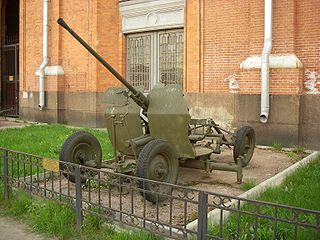
25 mm automatic air defense gun M1940 (72-K) was a Soviet 25 mm caliber anti-aircraft gun used during the World War II. The gun was developed from the end of 1939 to the beginning of 1940 at 8th Kalinin Artillery Plant under the guidance of its Chief Designer Mikhail Loginov, supervised by Lev Loktev. The cannon was given the factory code 72-K before being accepted into service by the Red Army as the 25 mm automatic air defense gun M1940.
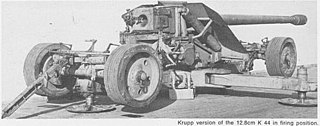
The 12.8 cm Pak 44 is a German anti-tank gun used during World War II. It was designed as a result of experiences on the Eastern front in 1943. The German Army came upon the Soviet 122 mm field guns and issued a requirement for a similar weapon. Development initially concentrated on a field gun known as the Kanone K 44. However, once heavier Soviet tanks such as the IS-2 started to appear, the design requirements were altered to include an anti-armour role.

The 8 cm Feldkanone M.5 was a field gun used by Austria-Hungary during World War I. It was a conventional design, with its most notable feature being its obsolescent autofrettaged bronze barrel, necessary because Austria-Hungary still had trouble making steel of the proper quality.
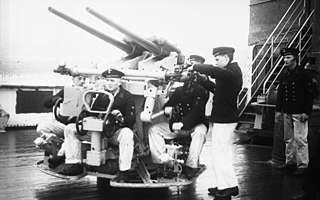
The 3.7 cm SK C/30 was the German Kriegsmarine's primary 3.7 cm (1.5 in) anti-aircraft gun during the Second World War. It was superseded by the fully automatic 3.7 cm FlaK 43 late in the war.
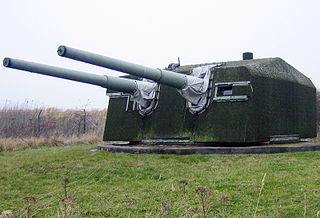
The 15 cm SK C/28 was a German medium-caliber naval gun used during the Second World War. It served as the secondary armament for the Bismarck class and Scharnhorst-class battleships, Deutschland-class cruisers and the Graf Zeppelin-class aircraft carriers. A number of surplus weapons were used as coast-defense guns and eight were adapted to use Army carriages and used as heavy field guns as the 15 cm Schiffskanone C/28 in Mörserlafette
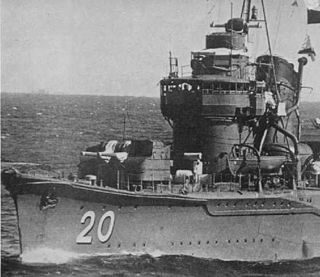
The 12.7 cm/50 Type 3 naval gun was a medium-caliber naval gun of the Imperial Japanese Navy used during World War II. It was the standard weapon for Japanese destroyers between 1928 and 1944. It has been credited as a true dual-purpose gun, but this was more a nominal capability than real, as its bag propellant and need for hand ramming required the gun to be loaded at elevation angles of 5–10°. This dropped its rate of fire to a relatively slow 5–10 rounds per minute, and its training speed of only 6° per second meant that it had a great deal of difficulty engaging enemy aircraft with any chance of success. After the end of World War II, the gun was exported via the two Japanese destroyers ceded as war reparations to the Soviet Union and the Republic of China.

The Canon de 75 contre avion modèle 1940 Schneider was a French 75 mm anti-aircraft gun designed and manufactured by Schneider et Cie at Le Creusot. These guns were used by the French Army during the Second World War.

The 5 cm FlaK 41(Flugabwehrkanone 41) was a German 50 mm (2.0 in) anti-aircraft gun produced for defending the intermediate zone above the range of light guns, but below the ceiling of the heavy pieces. The gun proved inadequate and was produced only in small numbers.

The 12.8 cm FlaK 40 was a German anti-aircraft gun used in World War II. Although it was not produced in great numbers, it was reportedly one of the most effective heavy AA guns of its era.

The 8.8 cm Flak 16 was a German 8.8 cm anti-aircraft gun from World War I, forerunner of the 8,8 cm FlaK/PaK Flak 18/36/37 of World War II. Its contemporary name was the 8,8 cm K.Zugflak L/45.

The Canon de 75 antiaérien mle 1913–1917 were a family of French 75 mm anti-aircraft guns designed and manufactured by Schneider et Cie at Le Creusot. The guns were used by the French Army during the First World War and Second World War.

The 7.7 cm FlaK L/35 was a German 77 mm anti-aircraft gun produced by Krupp during the First World War.

The 7.62 cm FlaK L/30 was a German 76.2 mm anti-aircraft gun produced by Krupp during the First World War.


















